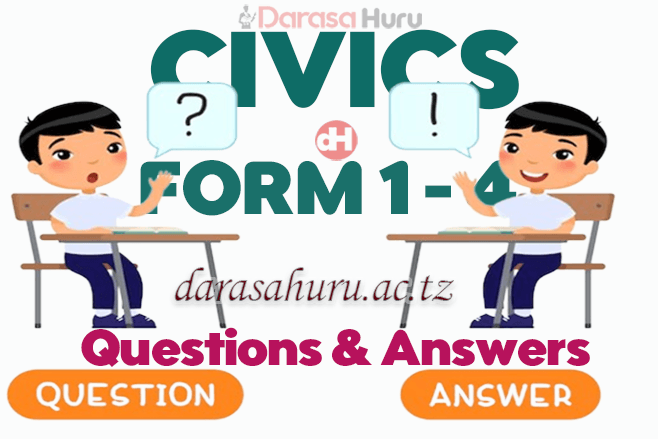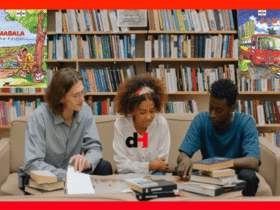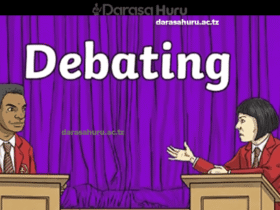Chapter Seven – Responding to Oral and Written Communication – English Form Two
Introduction
Understanding and responding to spoken and written communication enables you to participate actively in class, complete assignments and perform well overall. In this chapter, you will learn how to express opinions in response to spoken and written communication appropriately.
You will explore the importance of responding to non-verbal communication cues appropriately. Additionally, you will practice responding to non-verbal cues appropriately in various communication settings.
The competencies developed will improve your ability to communicate respectfully and thoughtfully in different communication settings.
Think about:
- the difference between an idea and opinion.
- the importance of sharing your opinion.
- someone responding to your opinion rudely.
Activity 1: Expressing ideas and opinions in communicative settings
(a) Study the following picture and answer the questions that follow.
Questions
- What is happening in this picture?
- What is the importance of preserving Tanzania’s forests? Why?
- What is your perspective on the claim that the demand for charcoal is a major cause of deforestation?
- How does cutting down trees negatively affect Tanzania?
- What are the five measures to be taken to prevent Tanzania from losing its forests? Use the cues provided following the ‘Did you know’ section to make your arguments.
Did you know?
Expressing opinions is important for effective decision-making, as it allows individuals to contribute to positive outcomes. This skill is important in various settings, including home, school and work. It can significantly impact family decisions, discussions in meetings and collaboration at work. Additionally, sharing opinions during public meetings and discussions with friends helps address community issues and personal matters. Phrases such as those listed in the following box are used by speakers to introduce their ideas and opinions.
Opinion Expressions
You studied some constructions for expressing opinions in Form One. You will practise using additional constructions you learn in conversation here. Phrases such as those listed in the box follows are used by speakers to introduce ideas and opinions.
(b) Determine if the following constructions express agreement or disagreement with opinions. Fill the constructions in their respective columns in the table given.
| S/n | Agreeing | Disagreeing |
|---|---|---|
| 1. | ||
| 2. | ||
| 3. | ||
| 4. | ||
| 5. | ||
| 6. | ||
| 7. | ||
| 8. |
(c) Practise the following dialogue to improve your skills in giving opinions. Identify the opinion constructions in the dialogue.
Rehema: Hi Giovani, what’s your opinion about town life compared to village life?
Giovani: I think town life is better because of the improved social services available.
Rehema: I agree with you, but I’m of the opinion that living in the village has its benefits. For example, we do not have to pay for water in our village since it’s freely available from rivers and wells.
Giovani: I see your point, but I’m concerned that water from rivers and wells can lead to health issues, like diarrhoea and typhoid, which are common in the village.
Rehema: That might be true, but I don’t think it is fair to generalise. Many people boil or treat water before using it.
Giovani: Mmmh! I get the impression that you are being too defensive. Additionally, where do they get the firewood to boil the water? I strongly believe that they are cutting down too many trees.
Rehema: I agree with you on that point. That’s why I think it’s important for our villages to have access to affordable and reliable gas and electricity. To me, gas and electricity is the best solution.
Giovani: That’s an excellent idea, but don’t you think that might be too expensive for the villagers?
Rehema: Maybe, but I believe that the government is working on providing gas and electricity services to villages at a reasonable cost.
Giovani: You’re right.
Adapted from TIE (2018): English for Secondary School Form Two.
(d) Give your opinions on the following topics using the opinion constructions of your choice.
- Parents should check their children’s progress at school every day.
- Corruption is an enemy of progress.
- Students should reduce their use of digital devices and social media to maintain mental well-being.
- Respecting different opinions may undermine unity in a community.
- Posting videos and comments on social media can be done without considering others’ feelings.
(e) Study the following text to enhance your skills in agreeing with others’ opinions politely.
Agreeing with Others’ Opinions
Respecting others’ opinions crucially shows that you value their knowledge and contributions to the topic. When you respect others, it helps to build good relationships and encourages them to be positive. It is a way of showing that you think they are important. It also shows the respect you expect them to reciprocate. See the following examples of agreeing with others’ opinions.
| An opinion | Agreeing with an opinion |
|---|---|
| From my point of view, every citizen should pay taxes to the government. | Perfect, taxation is one way to address income inequality. Greater contributions from rich people can support those with low incomes. |
| Some people claim that paying taxes costs both individuals and businesses. | I agree with them that taxes are an expense for both individuals and companies, but they also improve the welfare of their customers. |
| To me, taxes are necessary to pay for infrastructure and public services that benefit all citizens | I agree that taxes play a crucial role in providing funding for public services and infrastructure. |
(f) Use the following constructions to express your agreement with others’ opinions.
(g) Study the following dialogue between Rosa and Halima. Then, respond to the items that follow.
Halima: Hi Rosa, what’s your perspective on whether paper-and-pencil tests should be abolished in secondary schools?
Rosa: Oh, it’s quite an interesting topic. I personally think they should be abolished. The entire practice seems outdated.
Halima: That’s a unique perspective, but I should respectfully disagree. I believe such tests are still relevant today as they are a standardised measure of assessment.
Rosa: Well, I can see why you think so, but don’t you see that solely relying on paper-and-pencil tests is insufficient?
Halima: Yes! You raise an important point, but equally important paper-and-pencil assessments are useful for assessing problem-solving and critical-thinking abilities.
Rosa: I agree up to that point, but have you taken on board the fact that these tests usually impose unnecessary tension on us?
Halima: I can see what you mean. Nevertheless, while standardised tests can be stressful, they offer a yardstick for comparing our academic performance with others.
Rosa: I see your point, but wouldn’t you agree that other ways to evaluate us could be less stressful?
Halima: That’s an interesting opinion. Nonetheless, I still trust that paper-and-pencil assessments can strike a balance by giving an objective measure of knowledge.
Rosa: You make a valid point, but I’d argue that leveraging multiple assessment methods could practically improve the overall evaluation process.
Halima: What a thoughtful perspective! I can also see the strengths of utilising various assessment methods. Balancing traditional and innovative approaches to cater to diverse learning needs is worth considering.
Rosa: I agree. A balanced approach is indeed the best option.
Halima: I appreciate your openness to compromise. It seems we both agree that there’s no one-size-fits-all answer.
Rosa: Precisely my point. It’s great to have a broader, constructive discussion about this.
Halima: I couldn’t agree with you more. I’m grateful for our engaging conversation, Rosa. It’s always good to explore different viewpoints.
Rosa: Likewise, Halima. Conversations like these broaden our perspectives to see things from various lenses.
Halima: By the way, I have to prep for tomorrow. Take care!
Rosa: Bye!
Practice
- Analyse five polite expressions of disagreement in the dialogue above.
- Use online sources to search for other polite expressions of disagreement.
- Employ the polite expressions you have identified in 1 and 2 to construct a dialogue on the topic “Technology in the classroom is more harmful than beneficial.”
Did you know?
People often find themselves in disagreement during everyday conversations. It is important to express differing opinions to foster diverse perspectives. However, expressing disagreement rudely can damage our relationships with others. To prevent this, we should use polite ways to show our dissent. In essence, we should strive to disagree respectfully.
(h) Read the responses to opinions in Groups A and B. Think about how communication is impacted by each group’s responses. Share your opinions with your partners orally.
| Group A: Impolite disagreement | Group B: Polite agreement |
|---|---|
| Just stop talking. | That’s an interesting idea. Have you considered an alternative? |
| That’s a stupid idea. | I see why you are saying so, but I think there might be other factors to consider. |
| You don’t know what you are talking about. | I understand your viewpoint, but I have a different perspective |
| That is the dumbest thing I have ever heard. | Could you help me understand it better? |
| Are you serious? Is that a suggestion to make? | That’s a unique perspective. I have a slightly different view. |
| I don’t care what you think. | Could we discuss how we might address the concerns you have raised |
Activity 2: Using appropriate non-verbal cues in group communication
(a) Play the Emoji Charades game by choosing an emoji from the set and acting it out using body language and facial expression. The rest of the class must guess which emoji it is and what emotion or message it represents.

Did you know?
In everyday communication, we use more than just words to express our ideas and feelings. Visual images, facial expressions, body language, posture and eye contact play an essential role in delivering and understanding messages.
Non-verbal communication cues help us to interpret messages, making our communication more meaningful and effective.
| Non-verbal cue | Meaning | Example of verbal responses |
|---|---|---|
| A sad face | Someone is disappointed. Someone needs empathy. |
Are you okay? Is there anything you would like? I am sorry about our problem! |
| A hungry face | Someone is hungry. | I have noticed you look hungry. Would you like something to eat? It looks like you might be hungry. We should find a place to grab a bite. |
| Shivering | Someone is sick. Someone is nervous. Someone is excited. |
Is there anything I can do to make you comfortable? Are you feeling cold? Do you feel unwell? It looks like you are excited. What’s going on? You look very excited. |
| An appropriate dressing | Someone is formal. Someone is professional. Someone is serious. |
You look great! Your outfit is perfect. You have nailed the look. It’s great to see you looking so. |
| An inappropriate dressing | Someone is unprofessional. Someone is not serious. Someone is informal. |
(If possible, talk to the person privately to avoid embarrassment.) Your outfit does not align with the dress code. Do you feel comfortable with your outfit? |
| A smiling face | Someone is happy. | What is making you smile today? You have had a good day so far. What made you feel so happy? |
(b) Role-play a scenario where one student communicates using non-verbal cues, and the other responds verbally to what they interpret from the non-verbal cues.
(c) Watch a silent movie clip and describe what the characters feel or try to communicate based on their facial expressions and gestures.
Exercise 1
Describe how you would use different clothing styles to convey different messages to your audience or viewers. Explain what each style means and what message it gives.
Exercise 2
(a) Which of the following non-verbal responses are inappropriate when the class is in progress? Why do you think the rest are appropriate?
- Nodding, tilting your head, clapping
- Taking notes
- Audio/video recording the teacher without permission
- Rolling your eyes
- Showing frustration
- Talking to someone else
- Yawning loudly
- Appearing bored
- Playing with objects
- Facing away from the teacher
(b) How would you respond to the inappropriate non-verbal communication cues mentioned in A?
(c) Describe how different personal appearances may communicate different messages.
Did you know?
In communication, people often respond to non-verbal cues with non-verbal actions. For example, one might return a smile back to someone who smiles at them or adopt a polite expression if someone appears upset.
However, non-verbal cues alone may not be enough. People frequently use spoken language to articulate their understanding of these non-verbal cues. The combination of both verbal and non-verbal cues enhances the effectiveness of communication.
Responding to non-verbal communication is crucial to convey that we understand others’ thoughts and feelings, even when they are not speaking. Responding to non-verbal communication can significantly improve our interpersonal relationships and overall communication skills.
Activity 3: Using appropriate grammar and vocabulary for oral communication in a variety of contexts
(a) Describe a school, market, train station, or home using prepositions (e.g. near, between, in front of, behind, next to, above, below, inside, outside, on the corner of) adjectives (e.g. beautiful, crowded, quiet, spacious, historical, modern, colourful, small, large) adverbs (e.g. calmly, brightly, loudly, peacefully, busily, neatly, beautifully.)
Example
The train station is located between the city’s famous shopping mall and the main road. It is always crowded with passengers arriving from different parts of the country or travelling to yet other parts of the country. In the departure lounge, there are beautifully arranged benches on which passengers sit, waiting for their time of departure. To ensure everybody hears clearly, announcements are made loudly over the speakers. Normally, announcers sound friendly and polite. Before the train arrives, people wait patiently and sometimes anxiously.
(b) A quantifier is a word or phrase that expresses the amount or number of something. It helps to indicate how much (for uncountable nouns) or how many (for countable nouns) of something is being referred to in a sentence. For practice, underline quantifiers from the following sentences.
- There are a few oranges on the table.
- Several birds are sitting on the fence.
- She has many good friends.
- There are too many cars on the road today.
- There is a little milk in the fridge for the baby.
- I need a bit of sugar for coffee.
- There isn’t much water left in the bottle.
- There is some rice left.
- Do you have any questions?
- A lot of people attended the event last night.
- None of the students failed the test.
Practice
A customer goes to the shop to buy a few items. Imagine you overhear his conversation with the shopkeeper. Write a dialogue of that interaction using as many quantifiers as possible.
(c) Role play a customer and seller where a customer wants to buy an item but thinks the price is too high, while the seller tries to convince them to buy at the given price or negotiate a fair deal. Use phrases like May I…, I would like…, could you …, I offer you…
(d) Role play the following scenario.
At the Hospital
Imagine feeling unwell and going to a clinic to see a doctor. You need to describe your symptoms and how you think, and request a check-up. Write a dialogue where you will roleplay as a patient and a doctor. First, greet the doctor. Then, explain your symptoms (e.g., headache, fever, stomach ache, vomiting, coughing, diarrhoea, etc), ask about the consultation cost, and request medication. The doctor should respond to explanations and questions.
Activity 4: Creating a variety of texts for different communicative purposes using appropriate tone and register
(a) Study the following claim/request letter and complete the task that follow.
Tulipo Secondary School,
P. O. Box 10,
Songwe
5th March, 2026.
The Academic Teacher,
Tulipo Secondary School,
P. O. Box 10,
Songwe
Dear Sir/Madam,
RE: REQUEST FOR EXAMINATION RESULTS REPORT
I hope this letter finds you well. I am requesting my examination results report for the June terminal Examinations. I would like to inform you that I have not yet received my results, and I kindly ask for your assistance in providing them at your earliest convenience.
Please let me know if there is any procedure that I need to follow to obtain the report. I would appreciate your prompt response regarding this matter.
Thank you for your time and assistance. I look forward to your reply.
Yours sincerely,
MNjala
Mbumi Njala
Practice
Write a request letter asking one of the following:
- New learning facilities (e.g., more books, computers, classroom equipment).
- Sports gear (e.g., footballs, basketballs, jerseys).
(b) Study the following email and complete the task that follows.
From: Koku Kashozi koku.kashozi@example.com
To: Ms. Leila leila@example.com
Subject: Concern regarding lack of school books in the school library
Dear Ms. Leila,
I hope this email finds you well.
I am writing to bring to your attention an ongoing issue regarding the lack of sufficient textbooks in our school library. Despite numerous requests, we have not yet seen the necessary books for Form Three. Many students are not visiting the library, which hinders their ability to engage effectively with the materials.
We would greatly appreciate your support in addressing this situation and ensuring the required textbooks are provided as soon as possible. Addressing this will allow all students to continue with their studies without disruption.
Thank you for your attention to this matter. I look forward to your response.
Best regards,
KKashozi
Koku Kashozi
Form Three Student
Practice
Imagine you are a boarding school student about to break for the September Mid-Year holiday. Email your parent or guardian requesting money for bus, train, or flight fare.
(c) Compose short stories on two of the following topics. Use phrases such as Once upon a time…, I wonder… What if…, Back in time…
- The homeless dog’s secret – A lonely stray dog keeps following you home. One day, you discover it has a special secret. What is the secret, and how does it change your life?
- The forgotten village – Abdul discovers an old map leading to a hidden village/town that no one remembers. What mysteries lie ahead?
- What if I woke up one day and everything had changed?
- Back in time, people used to write letters instead of texting…
(d) Study the following pictures and identify the non-verbal cues represented. Then, write a paragraph for each picture to describe what is happening.
Effective Communication Tips
- Always consider your audience when choosing words and tone
- Use appropriate register (formal/informal) for different situations
- Pay attention to both verbal and non-verbal cues
- Practice active listening in all conversations
- Be respectful when expressing disagreement
- Use clear and specific language
- Adapt your communication style to different contexts































Leave a Reply